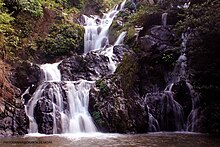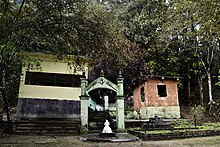Nagaon is an administrative district in the Indian state of Assam. At the time of the 2011 census it was the most populous district in Assam, but since Hojai district was split that title was lost to Dhubri.
History
| Year | Pop. | ±% p.a. |
|---|---|---|
| 1901 | 194,534 | — |
| 1911 | 225,344 | +1.48% |
| 1921 | 297,322 | +2.81% |
| 1931 | 420,263 | +3.52% |
| 1941 | 484,874 | +1.44% |
| 1951 | 662,579 | +3.17% |
| 1961 | 900,537 | +3.12% |
| 1971 | 1,251,636 | +3.35% |
| 1991 | 1,893,171 | +2.09% |
| 2001 | 2,314,629 | +2.03% |
| 2011 | 2,823,768 | +2.01% |
| source: | ||
Batadrowa gave birth to the Vaishnavite reformer Sankardev, who brought about a renaissance in Assamese society. Located in Assam’s heartland, Nagaon lies at the center of northeast India. The district dates to 1833. Its British administrators jocularly described Nagaon as a district of 3 C’s; namely: Chickens, Children and Cases.
The region was called Khagarijan in older records.
On 15 August 2015, Hojai district was formed out of Nagaon.
Geography
The district headquarters are located at Nagaon. Kaziranga National Park is nearby. The district is bounded by Sonitpur district and Brahmaputra river in the north, Karbi Anglong and North Cachar Hills in the south, East Karbi Anglong and Golaghat district in the east.
Demographics
The residual district has a population of 1,892,550.
Religion
According to 2011 Indian Census, the Muslims form a slight majority in the district with 10,63,538, with Hindus accounting for 801,181, followed by 0.95% Christians. Small populations of Sikhs, Buddhists and Jains also reside in the district.
Languages
Languages spoken in Nagaon district (2011)
According to the 2011 census, 77.17% of the population speaks Assamese, 16.78% Bengali and 1.31% Hindi as their first language.
Economy
Agriculture is the backbone of the district and of Assam state. Rice is the principal crop and is the staple food. Fisheries are another major economy of Nagaon.
Culture
Many Namghars and associated templates are in Nagaon. These include the Bharali Namghar, which is situated in Hatbar and Borduwa Namghar. This namghar is situated in Nagaon Sattra, where Mahapurush Sankardev was born. Saubhagya Madhav, Dulal Madhav and Gopal Madhav are temples built during the reign of the Ahom King Shiba Singha.
Attractions
|
|
This section does not cite any sources. (September 2019)
|
Bordowa

Bordowa thaan
- This is the birthplace of Mahapurush Srimanta Sankardev (1449-1568) the artist, author, founder of Vaishnavism religion and dramatist. The two Sattras are Narowa Sattra and Salaguri Sattras. The mini Museum is there in Narowa Sattras

Inside the main temple of Borduwa Thaan in Nagaon district of Assam
Champawati Kunda
-

Waterfalls near Chapanala in Nagaon district of Assam
Champawati Kunda is a waterfall situated in Chapanala in Nagaon district.
Kaliabor
- Town that was the headquarters of Barphukans during the Ahom kingdom. It was the scene of several battles against the Mughals.

Trishuldhari temple at the bank of Brahmaputra in Silghat
Silghat
- Silghat is a river port lying on the South bank of the Brahmaputra. Pre-communication links of Central Assam across the Brahmaputra traverse this port town. Silghat hosts the Assam Co-operative Jute Mill and several temples.
Raha
- Raha was an important Chowki during the Ahom kingdom. It became a trade centre for agricultural products such as paddy, jute and mustard. The Fishery Training College is there.
Kamakhya Temple
- The Kamakhya Temple is in Silghat. The Ashok Astami Melas held every year nearby. (This is not the Kamakhya Temple in Guwahati.)
Phulaguri
- It is the place where Phulaguri Dhewa happened in the month of October, 1861.It is said to be the first Peasants’ Movement in the entire north-east India.It happened due to the exploitation on the peasants by the then British Government including exorbitant rate of taxes in various types of agricultural products.Captain Singer, a British officer was killed during the Dhewa & his body was thrown into the Kolong river nearby.
Kaziaranga National Park
In 1974 Kaziranga National Park was established. It has an area of 175 km2 (67.6 sq mi). It shares the park with Golaghat district. It is also home to the Laokhowa Wildlife Sanctuary. It covers an area of 70.13 km². Its main attraction is the great Indian one-horned rhinoceros. Other animals include tigers, leopards, Asiatic buffalo, wild boar, civet cats, leopard cats and hog deer. Various species of birds and reptiles are also found there.
Sports
Football matches are held in Jubilee Field in Nagaon.
